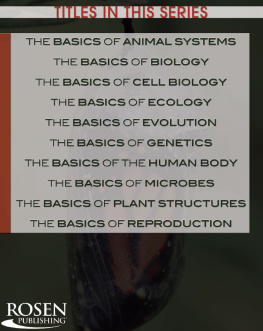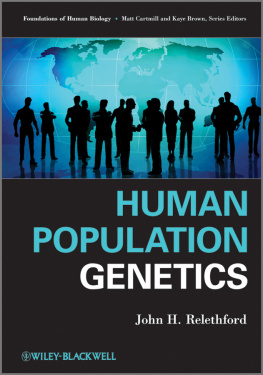Volker Hosel - Mathematical Population Genetics and Evolution of Bacterial Cooperation
Here you can read online Volker Hosel - Mathematical Population Genetics and Evolution of Bacterial Cooperation full text of the book (entire story) in english for free. Download pdf and epub, get meaning, cover and reviews about this ebook. genre: Home and family. Description of the work, (preface) as well as reviews are available. Best literature library LitArk.com created for fans of good reading and offers a wide selection of genres:
Romance novel
Science fiction
Adventure
Detective
Science
History
Home and family
Prose
Art
Politics
Computer
Non-fiction
Religion
Business
Children
Humor
Choose a favorite category and find really read worthwhile books. Enjoy immersion in the world of imagination, feel the emotions of the characters or learn something new for yourself, make an fascinating discovery.
- Book:Mathematical Population Genetics and Evolution of Bacterial Cooperation
- Author:
- Genre:
- Rating:4 / 5
- Favourites:Add to favourites
- Your mark:
- 80
- 1
- 2
- 3
- 4
- 5
Mathematical Population Genetics and Evolution of Bacterial Cooperation: summary, description and annotation
We offer to read an annotation, description, summary or preface (depends on what the author of the book "Mathematical Population Genetics and Evolution of Bacterial Cooperation" wrote himself). If you haven't found the necessary information about the book — write in the comments, we will try to find it.
Volker Hosel: author's other books
Who wrote Mathematical Population Genetics and Evolution of Bacterial Cooperation? Find out the surname, the name of the author of the book and a list of all author's works by series.
Mathematical Population Genetics and Evolution of Bacterial Cooperation — read online for free the complete book (whole text) full work
Below is the text of the book, divided by pages. System saving the place of the last page read, allows you to conveniently read the book "Mathematical Population Genetics and Evolution of Bacterial Cooperation" online for free, without having to search again every time where you left off. Put a bookmark, and you can go to the page where you finished reading at any time.
Font size:
Interval:
Bookmark:

GENETICS AND EVOLUTION OF
BACTERIAL C
 PERATION
PERATIONGENETICS AND EVOLUTION OF
BACTERIAL C
 PERATION
PERATIONVolker Hsel
Christina Kuttler
Johannes Mller
Technical University Munich, Germany

Published by
World Scientific Publishing Co. Pte. Ltd.
5 Toh Tuck Link, Singapore 596224
USA office: 27 Warren Street, Suite 401-402, Hackensack, NJ 07601
UK office: 57 Shelton Street, Covent Garden, London WC2H 9HE
Library of Congress Control Number: 2020010074
British Library Cataloguing-in-Publication Data
A catalogue record for this book is available from the British Library.
MATHEMATICAL POPULATION GENETICS AND EVOLUTION OF BACTERIAL COOPERATION
Copyright 2020 by World Scientific Publishing Co. Pte. Ltd.
All rights reserved. This book, or parts thereof, may not be reproduced in any form or by any means, electronic or mechanical, including photocopying, recording or any information storage and retrieval system now known or to be invented, without written permission from the publisher.
For photocopying of material in this volume, please pay a copying fee through the Copyright Clearance Center, Inc., 222 Rosewood Drive, Danvers, MA 01923, USA. In this case permission to photocopy is not required from the publisher.
ISBN 978-981-120-549-1
For any available supplementary material, please visit
https://www.worldscientific.com/worldscibooks/10.1142/11419#t=suppl
Desk Editor: Liu Yumeng
Printed in Singapore
Evolution is a tremendously complex process, and the choice of aspects and methods to focus on is mainly a matter of taste or interest. A central property of living organisms is the information stored more or less reliably in the DNA (for us, a kind of string with four letters). What is stored in the DNA can be passed from one generation to the next for a long, long time. The changes, based on mutations, are rather seldom (this statement, as everything else mentioned here, depends on the point of view, the organism one has in mind, and what is meant by changes). However, we learn that there are mechanisms that allow information to be passed only for few generations: epigenetics. And, of course, cell regulatory mechanisms allow to generate a short term memory that adapts the properties of an organism for a short time (seconds, minutes, or hours). What to focus on?
The discrete character of the DNA makes it difficult to work with tools that are essentially rooted in analysis. Which tools do we have? Which models can we develop? How can we analyze the models? Which questions are the central research questions to be answered?
Cooperation is of special interest. We are social individuals, and like to live together, work together, discuss together. We aim at a deeper understanding of cooperation. Humans are too complex to start with. We will focus on (perhaps) the most simple individuals that already show a social behavior, cooperation and even altruism: bacteria. Why is there cooperation in bacteria? Which mechanisms prevent cheaters to exploit and destabilize bacterial cooperation? One of the main reasons for this book is the vague feeling that we still do not understand all central ingredients of this important question though several fundamental approaches have been developed in recent years. Can individuals as simple as bacteria teach us humans about some of the basic mechanisms that create the glue that holds society together?
Structure of this book:
Prelude: Basic concepts and terms
We recall some basic and general ideas how to model biological systems, and some biological terms. This part can be easily skipped by any informed reader.
. Neutral evolution
We develop fundamental models, methods to analyze the models, and find the right questions we may ask. We consider the most basic setup, all individuals perform equally well. Think of hair color: if blonde or brown or red colored there is not much difference. We consider deterministic models for large populations (HardyWeinberg model), investigate the effect of stochasticity for models describing small, homogeneous groups (WrightFisher and Moran model), and investigate the effect of structure on evolution (evolution on finite graphs, or lattices the basic Voter Model). In particular, we consider the coalescence, an important tool in population genetics.
. Frequency-independent selection
We introduce differences in individuals, leading to different performance, in particular in different fitness. In frequency-independent selection, this difference does not depend on the population structure. A certain property (some individuals may be able to access an additional source to feed on, say) that allows a part of the population to reach a higher fitness compared with the other part, independently of the composition of the population. The superior type is more likely to take over the population than the inferior type. There are, of course, consequences in the mutation structure. We discuss these consequences.
. Frequency-dependent selection
Here we come to the situation that the fitness depends on the population structure. This is especially true in case of cooperation: The fitness of a defector, say, is higher if more cooperators are present in the population. We will discuss in particular if cooperators can spread in a population of defectors, or if they can persist. A main tool to model cooperation is game theory, and the replicator equation, which is based on game-theoretical ideas. We meet here the unavoidable tragedy of the commons: cooperators are exploited by defectors, and eventually are superseded.
. Multilevel Selection
All considerations so far took place in a homogeneous population. However, individuals often live together in small groups, e.g., tribes, villages or in case of bacteria: colonies. Within these groups, there is, of course, a close interaction, while the interaction between two groups is weaker. At the first glance, it is not clear why the setting with several groups should have a different outcome, compared with the investigation of one group only. It turns out that founder effects change the game. The initial composition of groups varies. In particular, with respect to cooperation, there are few groups that start mainly with cooperators and serve as nuclei from where cooperation can spread. This observation yields the famous Hamiltons rule, that shows that cooperation may spread in a multilevel setting, whereas it cannot spread in one single homogeneous population.
. Adaptive Dynamics
In a similar way as multilevel evolution extends the investigation of a well mixed to a structured population, also adaptive dynamics extends that theory. This time, the focus is not the spatial structure but the interactions. Two species, strains, or traits that live within one single, well mixed population, often compete for resources. Adaptive dynamics describes the consequences of this elementary observation. The basic assumptions are (1) the ecology of the system satisfies the principle of competitive exclusion (that is, at the ecological time scale one species out-competes all other species) and (2) mutant traits appear at a slow time scale. The first principle implies that at most time points, only one trait (the resident) is present in the ecosystem. From time to time, a new mutant appears. Initially, this mutant has a low frequency. Therefore, the state of the environment is determined by the resident. If the mutant is able to spread in that environment, it will take over (according to principle 1) before the next mutant appears (according to principle 2) and becomes the new resident. In that, evolution leads to a step in the properties of the resident. This process, the repeated invasion of the system by new mutants, and the subsequent reshaping of the environment is studied by adaptive dynamics. It is often possible to predict where the system will be driven to and even an event as speciation can be understood.
Font size:
Interval:
Bookmark:
Similar books «Mathematical Population Genetics and Evolution of Bacterial Cooperation»
Look at similar books to Mathematical Population Genetics and Evolution of Bacterial Cooperation. We have selected literature similar in name and meaning in the hope of providing readers with more options to find new, interesting, not yet read works.
Discussion, reviews of the book Mathematical Population Genetics and Evolution of Bacterial Cooperation and just readers' own opinions. Leave your comments, write what you think about the work, its meaning or the main characters. Specify what exactly you liked and what you didn't like, and why you think so.












